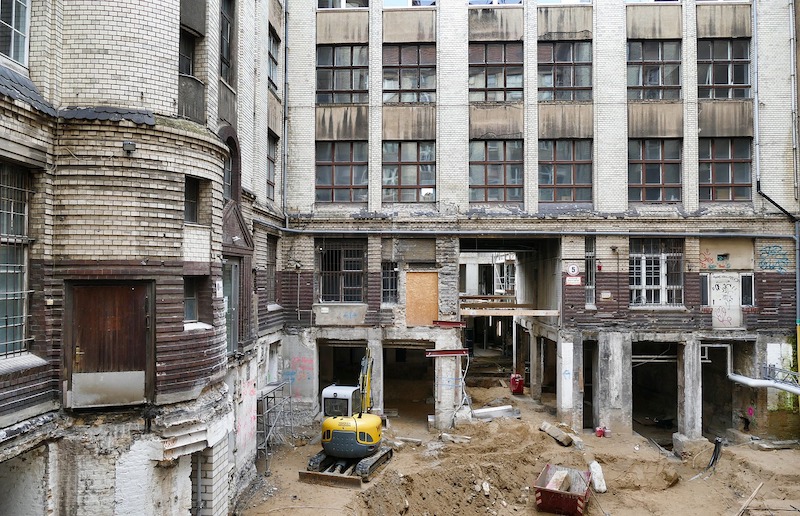For a market that receives little attention or fanfare, the U.S. reconstruction and renovation sector is the lifeblood for many of the nation’s architecture, engineering, and construction firms—large and small. From office fitouts to adaptive reuse to historic preservation to run-of-the-mill renovation work, more than $100 billion in construction spending flows into reconstruction projects each year.
For some perspective on the importance of this sector to the AEC market, we turn to the 2019 Giants 300 Report, BD+C’s annual ranking of the largest AEC firms in the country (BDCnetwork.com/Giants2019). Of the 486 companies that participated in the Giants report this year, 364 (74.9%) reported earning at least some design or construction revenue from reconstruction work in 2018. And more than a quarter (27.0%) of all reporting firms earned at least half of their total 2018 revenue from the reconstruction sector.
Then there are the specialists, like Clune Construction, Consigli Building Group, Hoffmann Architects, and Jensen Hughes, which garner three-quarters or more of their overall revenue from the reconstruction market (40 companies in all, or 8.2% of the Giants 300 reporting firms).
From a community impact perspective, few new construction sectors (outside of healthcare, perhaps) rival the reconstruction market, as evidenced by the 22 winning projects in our 36th annual Reconstruction Awards. When planned and executed properly, redevelopment projects not only save and reenergize dated or landmark structures, they can spark the revivification of entire neighborhoods and districts. Take, for example, the MGM Springfield development in Springfield, Mass. The city used this landmark casino project—it is the first full-service casino in Massachusetts—as a catalyst for a $960-million, 14-acre redevelopment in the heart of downtown. The project involved the restoration or reuse of several historic structures, including the relocation of the First Spiritualist Church and the adaptive reuse of the long-vacant State Armory building.
In Little Rock, Ark., an enterprising AE firm (Cromwell Architects Engineers) purchased the oldest remaining industrial building and turned it into The Paint Factory. The $7.9 million mixed-use redevelopment has been hugely successful since opening in March 2018, sparking some $75 million worth of new construction in the neighborhood.
There are numerous success stories among our 2019 Reconstruction Awards winners—from Linode’s new headquarters in a converted bank building in Philadelphia, to Springfield Technical Community College’s student services center in a military munitions manufacturing plant in Massachusetts. Check out these projects and more featued in the November 2019 issue of BD+C. Enjoy!
Related Stories
Libraries | Oct 30, 2024
Reasons to reinvent the Midcentury academic library
DLR Group's Interior Design Leader Gretchen Holy, Assoc. IIDA, shares the idea that a designer's responsibility to embrace a library’s history, respect its past, and create an environment that will serve student populations for the next 100 years.
Adaptive Reuse | Oct 22, 2024
Adaptive reuse project transforms 1840s-era mill building into rental housing
A recently opened multifamily property in Lawrence, Mass., is an adaptive reuse of an 1840s-era mill building. Stone Mill Lofts is one of the first all-electric mixed-income multifamily properties in Massachusetts. The all-electric building meets ambitious modern energy codes and stringent National Park Service historic preservation guidelines.
Brick and Masonry | Oct 7, 2024
A journey through masonry reclad litigation
This blog post by Walter P Moore's Mallory Buckley, RRO, PE, BECxP + CxA+BE, and Bob Hancock, MBA, JD, of Munsch Hardt Kopf & Harr PC, explains the importance of documentation, correspondence between parties, and supporting the claims for a Plaintiff-party, while facilitating continuous use of the facility, on construction litigation projects.
Adaptive Reuse | Sep 12, 2024
White paper on office-to-residential conversions released by IAPMO
IAPMO has published a new white paper titled “Adaptive Reuse: Converting Offices to Multi-Residential Family,” a comprehensive analysis of addressing housing shortages through the conversion of office spaces into residential units.
Codes and Standards | Sep 3, 2024
Atlanta aims to crack down on blighted properties with new tax
A new Atlanta law is intended to crack down on absentee landlords including commercial property owners and clean up neglected properties. The “Blight Tax” allows city officials to put levies on blighted property owners up to 25 times higher than current millage rates.
Resiliency | Sep 3, 2024
Phius introduces retrofit standard for more resilient buildings
Phius recently released, REVIVE 2024, a retrofit standard for more resilient buildings. The standard focuses on resilience against grid outages by ensuring structures remain habitable for at least a week during extreme weather events.
Adaptive Reuse | Aug 29, 2024
More than 1.2 billion sf of office space have strong potential for residential conversion
More than 1.2 billion sf of U.S. office space—14.8% of the nation’s total—have strong potential for conversion to residential use, according to real estate software and services firm Yardi. Yardi’s new Conversion Feasibility Index scores office buildings on their suitability for multifamily conversion.
Adaptive Reuse | Aug 22, 2024
6 key fire and life safety considerations for office-to-residential conversions
Office-to-residential conversions may be fraught with fire and life safety challenges, from egress requirements to fire protection system gaps. Here are six important considerations to consider.
Reconstruction & Renovation | Aug 19, 2024
Movement to protect historic buildings raises sharp criticism
While the movement to preserve historic buildings has widespread support, it also has some sharp critics with well-funded opposition groups springing up in recent years. Some opponents are linked to the Stand Together Foundation, founded and bankrolled by the Koch family’s conservative philanthropic organization, according to a column in Governing magazine.
Sustainability | Aug 14, 2024
World’s first TRUE Zero Waste for Construction-certified public project delivered in Calif.
The Contra Costa County Administration Building in Martinez, Calif., is the world’s first public project to achieve the zero-waste-focused TRUE Gold certification for construction. The TRUE Certification for Construction program, administered by Green Business Certification Inc. (GBCI), recognizes projects that achieve exceptional levels of waste reduction, reuse, and recycling.

















